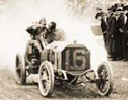Keeping It Off the Wall
by Ed Donath
Panoz in the Streets
10/13/05
Athens, NY—Just when there was a glimmer of hope that Champ Car’s improved management and respectable attendance figures might stimulate multiple engine and chassis manufacturers to join our beloved speed sport, helping to recreate and perhaps surpass the world class competitiveness that the series once enjoyed, reality slapped us in the face once again.
In the name of cost control, a lowest-bidder chassis will be mated to a nominally tweaked version of the proprietary Cosworth 2.65-liter turbocharged V8 engine that has powered every Champ Car since CART’s major shareholder partnered with two other race-loving venture capitalists to purchase the physical assets of the bankrupt publicly owned company, effectively giving the Champ Car World Series a new lease on life.
For at least three years, beginning with the 2007 CCWS season, the newly announced spec-car formula will represent the acorn from which the OWRS partners hope their mighty oak will grow. Obviously, they are betting that the package’s significant cost benefits will not only spawn new participant interest but that remarkable price rollbacks might also reverse the trend of former CART team owners going “elsewhere” to achieve profitability. Most of those evacuees have discovered that the price of poker over there is not only higher but that the racing is less rewarding than originally perceived.
“This new car is 35% cheaper than our current car. We’re also building a 50% reduction in the cost of car parts—the wishbones, the uprights, the consumable parts—that teams go through each weekend,” Champ Car Technical Director Scot Elkins boasted.
“We’ve reduced the costs of all of those and the fact we’re using an American manufacturer [Elan Motorsports Technologies of Braselton, Georgia will be the manufacturer of the Panoz DP01 chassis] also helps a lot.” Presumably, the Made in USA factor will reduce freight costs and the expense of sending manufacturer’s representatives to race venues and testing locations.
“We're also exploring going to carbon fiber brakes,” Elkins added, “Because with the intense braking G-loads these cars create during a weekend, it eats up the metallic brakes, pads, and rotors. ALMS uses carbon technology and gets three to four races on a set of pads and rotors, so this could save our teams massive amounts of money as well."
Other touted aspects of the new package:
- Shorter/narrower/lighter dimensions combined with reconfigured wings and tunnels—designed to reduce aerodynamic turbulence—should facilitate overtaking, particularly in the tight street circuits that comprise a disproportionate majority of Champ Car’s events.
- Onboard starters should help decrease the number of yellow flag laps.
- Driver safety features and crash worthiness have been enhanced.
“So what could be bad?” The Champ Car Company will have more teams and the chance for bigger profits. Team owners will find it easier to acquire sponsors in a low-budget environment. Drivers will enjoy competing in larger fields while driving safer, racier cars.
Well, for starters, top-flight international motorsports from f-1 to the various touring car series to Le Mans type racing to rallying, all achieve a major share of their technological mystique—and fan following—from a multiplicity of manufacturers’ technologies. In the days when CART had as many as four simultaneous regular engine manufacturers, three chassis makers and two tire suppliers there were nearly as many Mercedes-Benz banners being waved in the stands as there were Brazilian national flags.
From a long-time fan’s perspective, condoning, enabling, and/or justifying a racing schedule that flies in the face of the essential multidisciplinary mandate of Champ Car racing is abhorrent. Perhaps the new package will perform well on short ovals, super-speedways, and natural terrain road courses but the design was conceived, primarily, to enable at least three more years of street festival mania above all else.
Finally, releasing the 2007 formula specs more than a full season before their activation will make it too easy for fans to forget—and for the series’ management to downplay—other elements of the marketing of Champ Car racing that need fixing as much or more than the current chassis/engine specs.
Road Rage! An op-ed feature by Ed Donath.
Copyright © 2005 by Ed Donath and Deep Throttle. All Rights Reserved.
Ed Donath Archive
| 



